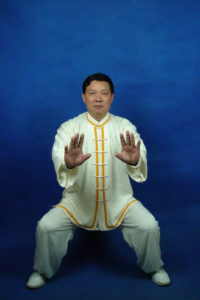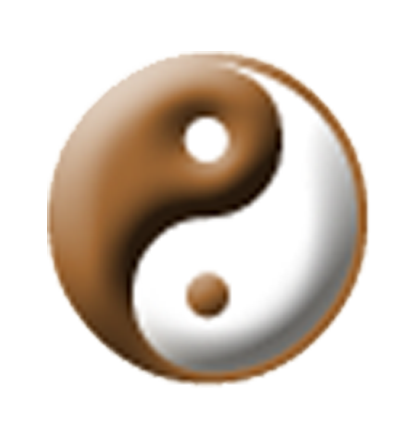02. Pushing the Mountain
Practice Method and Details
The following is from our book on Wudang Qigong, originally published in 1999. Photos of Professor Liu here are from 2006.

Set 2 Pushing the Mountain Exercise
In Pushing the Mountain, the inner breath gathers in the middle DAN TIAN,
Issuing or receiving, using and transforming do not change the countenance.
The triple burner is unimpeded, the BREATH is not obstructed,
strengthen the body, guard the health, protect the original BREATH.
1) Preparation
The movement method is exactly the same as for Extreme Emptiness Exercise, Preparation Postures. (see Illustrations 1-1, 1-2, 1-3, 1-4)
2) Extremely Empty Initially
The previous movement pauses slightly, after regulating the breath by breathing out and in two times, both legs extend and straighten, naturally standing erect. At the same time, both arms revolve outward, both hands follow this turning inward and rising up, the heels of the palms stop just below both breasts. The fingertips of both hands face front, the palms face up. At the same time as this, the DAN TIAN sinks inward, breathe in. The tongue presses against the upper palate, the teeth are slightly closed, the eyes look toward the front. (Illustrations 2-1 and 2-2)
The previous movement does not stop, the body’s center of gravity lowers, both legs bend at the knees squatting down and changing into a horse stance. At the same time, both arms revolve inward, both elbows close as if carrying something, the hands turn toward the front of the body in an arc shape and press down, stopping in front of the abdomen. The palms face down, the fingertips face forward. At the same time as this, the DAN TIAN sticks out, breathe out. The tongue is close to the lower palate, the teeth are lightly closed. The eyes look slightly downward, the INTENTION is on the DAN TIAN; the BREATH circulates through both the DU MAI and the REN MAI. (Illustration 2-3)
3) Pushing the Mountain Exercise
The previous movement pauses slightly, after regulating the breath by breathing out and in two times, both legs extend and straighten, naturally standing erect. At the same time, both arms revolve outward, both hands follow this turning inward and rising up, the heels of the palms stop just below both breasts. The fingertips of both hands face front, the palms face up. At the same time as this, the DAN TIAN sinks inward, breathe in. The tongue presses against the upper palate, the teeth are slightly closed, the eyes look toward the front. (Illustration 2-4)
The previous movement does not stop, the body’s center of gravity lowers, both legs bend at the knees squatting down and changing into a horse stance. At the same time, both arms revolve inward, the heels of the palms use strength, pushing toward the front along a level plane. The distance between the centers of the two palms and the centers of both breasts is the same width, the palms face forward; the fingertips face up. At the same time as this, the DAN TIAN turns sticks out, gradually breathe out. The tongue is close to the lower palate, the teeth are lightly closed. The eyes look through the center of the space between both palms toward the front and into the distance, the INTENTION is on the palms LAO GONG acupuncture points. (Illustration 2-5)
4) Blend the Elements with One Breath
The previous movement pauses slightly, after regulating the breath by breathing out and in two times, both legs extend and straighten, naturally standing erect. At the same time, both arms revolve outward, both hands follow this turning inward and rising up, the heels of the palms stop just below both breasts. The fingertips of both hands face front, the palms face up. At the same time as this, the DAN TIAN sinks inward, breathe in. The tongue presses against the upper palate, the teeth are slightly closed, the eyes look toward the front. (Illustration 2-6)
The movement methods are entirely the same as for Extreme Emptiness Exercise, Blend the Elements with one breath (see Illustration 1-8).
Main Points and Functions
The important point in practicing Pushing the Mountain Exercise is that the LAO GONG acupuncture points turn outward and send out BREATH. From the very beginning the shapeless and formless “Dao” created and sent out true original BREATH. True BREATH separates YIN and YANG, YIN and YANG develop and produce the three cai, four directions, five elements, eight trigrams and thereby giving birth to and transforming ten thousand things. Thus, returning to the original source and achieving the objective of a healthy body and long life. When raising the arms and breathing out, the requirement is to relax the shoulders and sink the elbows. The movement and the respiration must be inseparably coordinated and completely unanimous, when the hands stop, the breath in must be sufficient. Observe the ENERGY and SPIRIT inside, relax the whole body, the toes grip the ground, and the BREATH travels upward. Raise the body straight, the HUI YIN acupuncture point with the crown of the head center the BAI HUI acupuncture point above and below connect and reflect.
The timing of breathing out and the movement of lowering of the body must be together, the speed slow and well-distributed. When the LAO GONG acupuncture points face out, send out breath and push with the palms, the appearance is the same as if pushing a piece of wood on the water; or very much like the appearance of pushing a ball in the water. The whole body is covered by a type of “OUTER BREATH” and feels enveloped by (it); lead, mix, and sink the BREATH, slightly restraining it. Use the INTENTION to send out the BREATH; neither excessively extending nor not reaching. The method of neither expecting nor overly exerting must be employed, then it is possible to send out the BREATH and perform the exercise.
Practice Method:
Each time, practice 6 times or 9 times to make one set. Practicing again and again in succession is fine. The size of the movements, large or small, high or low is not restricted, but depends on the age or youth, the extent of physical strength, and the strength or weakness in the physique of the one who is practicing.
09/17/2016 Terri Morgan
